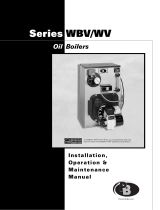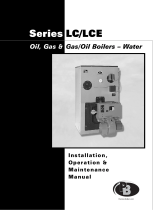Dunkirk SBO Installation & Operation Manual
- Type
- Installation & Operation Manual
This manual is also suitable for
Dunkirk SBO is a series of oil steam boilers designed for residential and commercial applications. It features a compact design, making it suitable for installation in tight spaces. The boiler offers high efficiency, with an AFUE rating of up to 86%, resulting in significant energy savings. It is equipped with a durable cast-iron heat exchanger, ensuring longevity and reliability. The SBO series is known for its user-friendly operation, with a programmable thermostat and intuitive controls for easy temperature management.
Dunkirk SBO is a series of oil steam boilers designed for residential and commercial applications. It features a compact design, making it suitable for installation in tight spaces. The boiler offers high efficiency, with an AFUE rating of up to 86%, resulting in significant energy savings. It is equipped with a durable cast-iron heat exchanger, ensuring longevity and reliability. The SBO series is known for its user-friendly operation, with a programmable thermostat and intuitive controls for easy temperature management.




















-
 1
1
-
 2
2
-
 3
3
-
 4
4
-
 5
5
-
 6
6
-
 7
7
-
 8
8
-
 9
9
-
 10
10
-
 11
11
-
 12
12
-
 13
13
-
 14
14
-
 15
15
-
 16
16
-
 17
17
-
 18
18
-
 19
19
-
 20
20
Dunkirk SBO Installation & Operation Manual
- Type
- Installation & Operation Manual
- This manual is also suitable for
Dunkirk SBO is a series of oil steam boilers designed for residential and commercial applications. It features a compact design, making it suitable for installation in tight spaces. The boiler offers high efficiency, with an AFUE rating of up to 86%, resulting in significant energy savings. It is equipped with a durable cast-iron heat exchanger, ensuring longevity and reliability. The SBO series is known for its user-friendly operation, with a programmable thermostat and intuitive controls for easy temperature management.
Ask a question and I''ll find the answer in the document
Finding information in a document is now easier with AI
Related papers
-
UTICA BOILERS TriFire TRB User manual
-
Dunkirk CSFE6225 Installation, Operation & Maintenance Manual
-
Dunkirk CSFE6225 Installation, Operation & Maintenance Manual
-
Dunkirk ESC V Steam Installation & Operation Manual
-
Dunkirk CSFE6225 Installation, Operation & Maintenance Manual
-
Dunkirk CSFE6225 Installation, Operation & Maintenance Manual
-
Dunkirk Empire EWC Installation & Operation Manual
-
Dunkirk ESC V Steam Installation & Operation Manual
-
Dunkirk ESC V Steam Installation & Operation Manual
-
Dunkirk ESC V Steam Installation & Operation Manual
Other documents
-
 PeerlessBoilers WBV Series User manual
PeerlessBoilers WBV Series User manual
-
PB Heat 1403007 Installation guide
-
 PeerlessBoilers EC-05-200 User manual
PeerlessBoilers EC-05-200 User manual
-
Burnham Series C Ratings
-
Bryant BW4 Owner's manual
-
Blaze BLZSB2IJ Owner's manual
-
 PeerlessBoilers LCE-16 User manual
PeerlessBoilers LCE-16 User manual
-
U.S. Boiler Company MST288SL-HB Installation guide
-
Crown Boiler Freeport 2 Steam Installation guide
-
Crown Boiler KSZ200 Installation guide






















